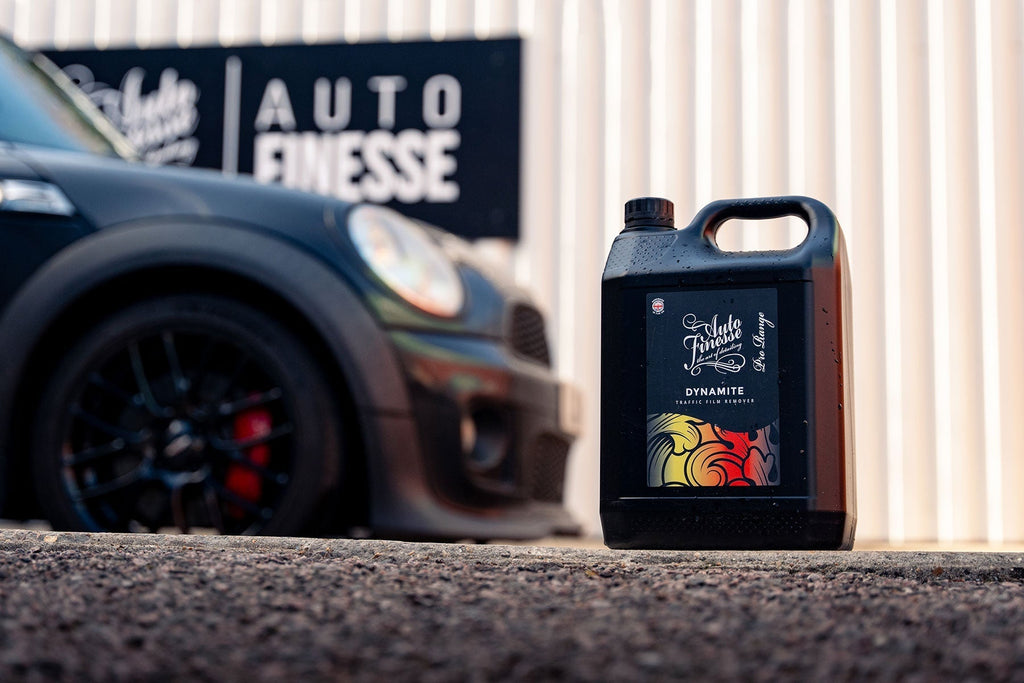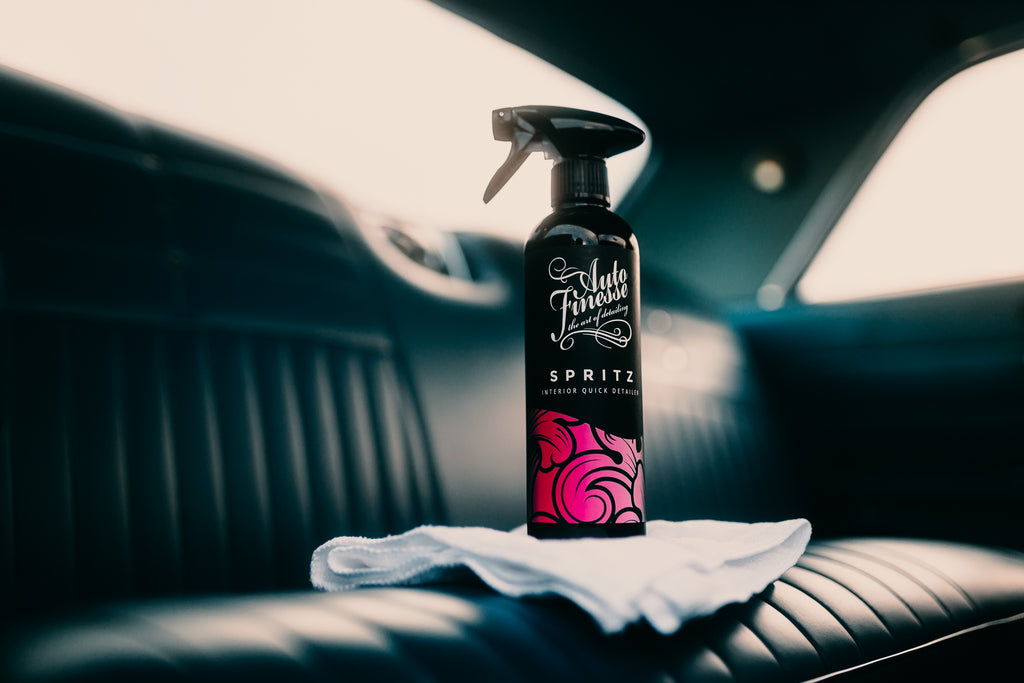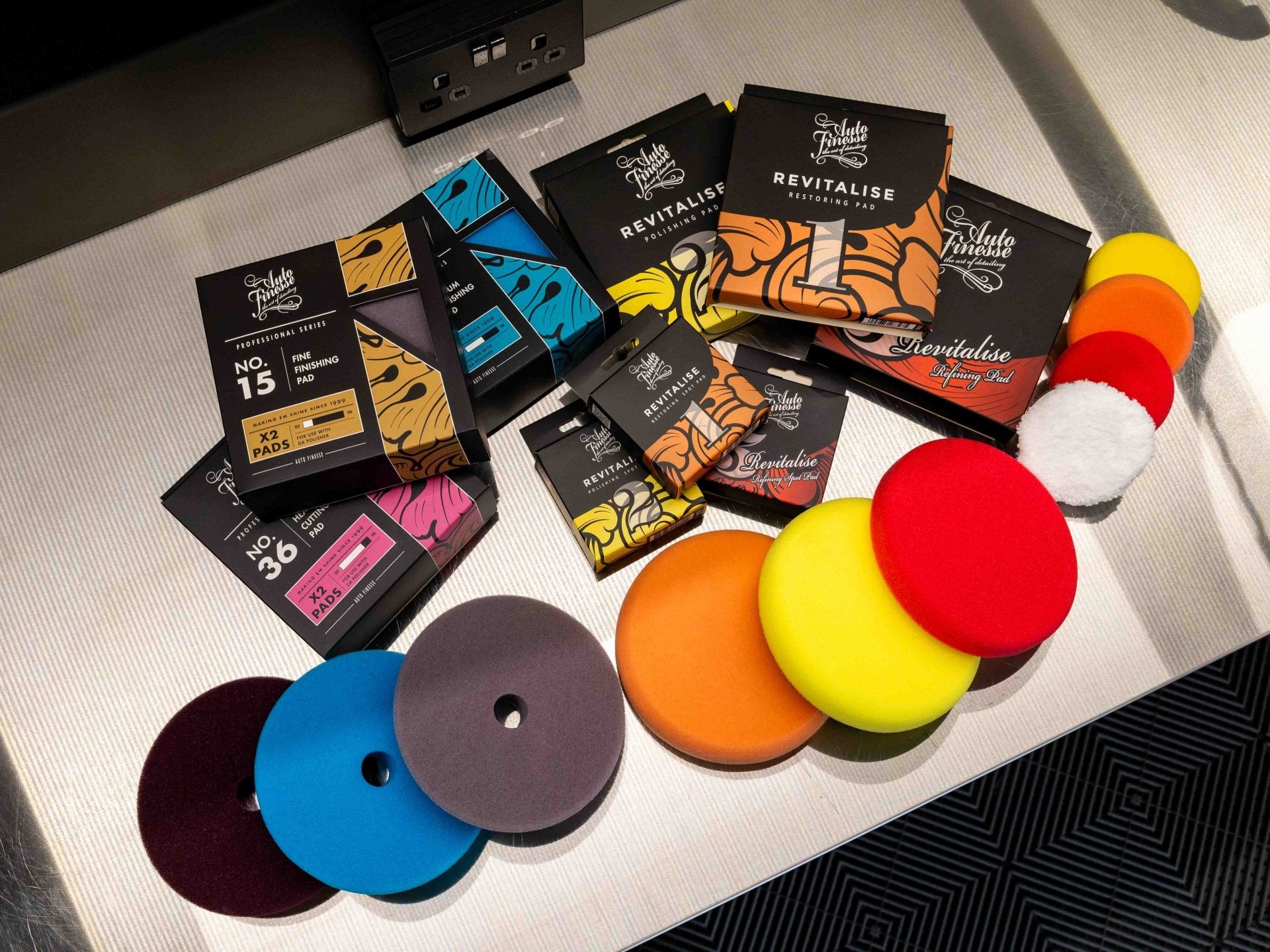Machine Polishing Pads: Everything You Need To Know

IN THIS GUIDE:
- Learn the difference between hand and machine polishing pads and the range of materials used in their construction.
- See which type of pad corresponds to each part of the paint correction process.
- Discover what pad to use with each product to get the best results every time.
Using The Correct Pad For The Job Is The Only Way To Achieve The Best And Most Consistent Results...
You can't get the best from your cars paintwork without polishing and you can't polish without a pad - that's not some kind of weird car detailing folklore, it's just a fact. When it comes to detailing products and accessories, you need the best to do the job right!
But, the real question is; how do you choose the correct pad to get the best results for various levels of correction and refinement, while avoiding any expensive mistakes along the way? Well, that's where we come in, so here's everything you need to know about every type of polishing pad…

What Is A Polishing Pad?
For the most part the term refers to Machine Polishing Pads - the most common being foam pads used for paint correction and refinement - but it can of course also include foam and microfibre pads, and applicators used for hand polishing, glazing and spot defect removal. Some pads - like our Revitalise Spot Pads can even be used for both hand or machine polishing.
For the most part here though, we'll be looking at finding the correct machine polishing pads for the job, but it's always worth remembering that hand polishing pads and applicators (which are usually constructed from the same materials), work in exactly the same way, just at a slower pace.
On the face of it there are many, many different types of polishing pad, but these can be quickly broken down into categories according to their size and materials used. In detailing circles at least there are three types of pad available - foam, microfibre and wool. The latter two are aggressive and used chiefly for heavy cutting and spot defect removal, while foam pads are available as different types to tackle everything from cutting to refining and finishing.
In terms of size and fit, the vast majority of modern pads that you'll come across use a hook and loop design to enable them to stick to the backing plate on the machine, these are most commonly found in 5-inch, 3-inch and 1-inch sizes to cater for the most common machine polisher sizes, but this is by no means all the sizes available. There are of course also foam pads that can simply screw directly to a machine polisher, but these tend to be used on rotary machines by refinishers in body shops to make freshly sprayed panels flat, relatively free of orange peel and "passable' after a repair. For the most part these are more of a "mopping' tool, than the sort of paint refinement essential we look for in the detailing world.

How Do Polishing Pads Work?
The first thing to remember is that, to an extent, polishing pads can be treated as a kind of abrasive, a bit like sandpaper, only far finer. We use them with various abrasive products like a polish or a compound of course, and they're designed to hold these products against surfaces to break them down and fully work them through, correcting or refining the surface at the same time. But, what's just as important as the product used on the pad is the performance of the actual pads themselves. This makes up a vital part of the detailer's 'combo' or the combination of product and pad and what effect it has on the surface. Using a different pad with the same polishing product is also a way of slightly varying the results to account for different types of paint and varying levels of defect.
Polishing pads simply work through friction, the level of which directly corresponds to how much of the surface of your paintwork a pad is able to take away during any cutting or refining process. You can find a full rundown on the science of machine polishing, including how surfaces are corrected on a microscopic level - in our Basic Guide To Machine Polishing.

Polishing Pad Materials
The materials used of course, will affect how, and how well, a machine polishing pad can do its job…

Wool & Microfibre Polishing Pads
Microfibre and Wool Pads are technically non-abrasive, but they are extremely aggressive when used with a relevant compound or polish, they will always give the abrasive product you're using far more bite. This is due to the natural or synthetic fibres having a much-increased surface area over foam, which in turn increases physical contact with the surface and aids friction. In simple terms this increase in heat helps to cut away more of the clearcoat/paint, chopping its way through surface layers in a much faster timeframe.
For the most part wool pads are the most aggressive and designed primeraly for use on rotary polishers. They will cut through the heaviest defects, easily, but will leave behind a surface that requires more refinement due to the abrasions and holograms that the cutting pad imparts along the way.
Microfibre pads are only slightly less aggressive, and will cut through the heavier defects, leaving behind tiny micro scratches and a cloudy surface that will need to be further refined to flawless. But critically, microfibre pads are available for use with dual action polishers, so to some extent they can be seen as a slightly safer option.
Although wool and microfibre spot pads are commonly used by detailers, this is generally only when a foam pad is not up to the task of cutting through particularly heavy defect on an in-depth multi-stage correction. Generally speaking, unless the paint shows significant damage or the vehicle has fresh paint which hasn't been effectively flatted and polished, foam pads are more commonly used for cutting medium to light defects. For finishing, glazing and polishing on single-stage enhancements, softer foam pads are always used.

Foam Polishing Pads
For obvious reasons, foam pads are the most popular in detailing circles, simply because they are available with such a varied level of cut and able to take care of all the most crucial stages of final paint refinement.
The aggressiveness of a foam pads will be dictated by their construction, which is always tailored the particular part of the correction process they are designed to carry out. This will vary from extreme cutting and flatting, most likely in a bodyshop, to the detailer's favourites of cutting, polishing and refining paintwork to a flawless finish. This is achieved through the density and the structure of the foam used in their manufacture, how it contacts the surface and the aptitude to build and retain heat within the foam itself.
Harder, denser foam is used for cutting simply because it brings more abrasion, more surface contact, and with it more heat. Lighter, less dense foam pads will be more suited to paint refinement and finishing. Although of course, it's always important to keep in mind that all these processes are technically still cutting, just on a finer and proportionally less aggressive level as you move on to refinement and finishing.
Just think of this type of multi-stage polishing (with less aggressive pads and products as you work down from stage to stage) as a process where you correct heavy defects first, and then correct the slighter and slighter defects left behind by the previous stage. The more aggressive the pad, the heaver the defect it can cut out, but the larger the defects it will leave behind to correct on the next stage, until eventually the defects are refined to a level that makes them invisible to the eye.


What's The Difference Between Open And Closed Cell Foam?
It's a commonly asked question, and it refers to the makeup of the foam itself. Foam is made up of thousands of microscopic cells packed together in a non-uniform mass. When it's manufactured, each of these individual cells have a kind of skeletal structure and a membrane or skin, which covers the entire outer surface to make up the outer cell wall. All these cells are stuck together, and this gives the body of foam. Imagine this as like a collection of steel framed buildings all clumped together. What's important here is that when the membrane remains intact, the foam is known as closed cell, and when the cell membranes are taken away through reticulation (a secondary manufacturing process which quite literally explodes the cells) to leave only the structure behind, this is known as reticulated or open cell foam.
So, on a microscopic level, closed cell foam is a bit like frogspawn in appearance, while open cell foam has more of a 3D honeycomb structure, this as you can imagine gives different characteristics when it comes to use as the contact surface in machine polishing pads.
Because of the tight knit structure and the fact that the cells are essentially sealed off, closed cell foam pads are extremely dense. And, although there not completely impermeable to air and liquids between the cells, they don't lend themselves particularly well to soaking in products. Here the compounds (along with any spent product and removed clearcoat/paint) will remain on the top of the surface and will tend to migrate to the middle of the pad as it spins. Airflow is also extremely restricted through closed cell foam, and for this reason it builds up heat extremely quickly and retains it over a relatively long period. This is why closed cell pads are generally reserved for the first stage of heavy cutting and defect removal using rotary polishers. You'll find that many closed cell pads are simply referred to as "cutting pads'. These also tend to be more difficult to clean effectively.
Conversely, open cell foam - like that which you'll find in our Machine Polishing Pads and Pro Pucks - tends to be safer during any correction process due to increased heat dispersal, especially when used in conjunction with a dual action polisher. The structure here is also porous meaning it actively soaks in the polishing product and is able to collect and lock away spent compound and removed paint particles deep down under the surface. Because of the variety of foam densities that can manufactured, open cell pads are also available in a wider range of firmness which means they can be manufactured to be relatively soft, making them ideal for the finest refinement, finishing down and the application of glazes. It doesn't mean a high-density open cell foam pad won't achieve a good, heavy cut, though. In fact, a good quality open cell foam item will offer a similar level of cut to any equivalent closed cell pad.

Density
Regardless of an open or closed cell construction, density refers to the stiffness of the foam used. Stiffer foam is by nature more aggressive on painted surfaces, the reason why denser pads are chiefly suited to cutting, and softer pads can be used for refinement and finishing.
What's less commonly known is that the density of foam actually changes as you work. As a pad becomes saturated with polishing products, and when it heats up during use, the density of the foam is be reduced. In practical terms at least, this means that cutting performance will also diminish, and it's the reason why a new, dry pad will cut more readily than a pad that has been used for some time over multiple panels. This is just one of the reasons why we regularly clean out pads between polishing sets, to attempt to keep the effectiveness of the cut.
The density change when in use is something that should be taken into consideration when specifying how many pads to use over an entire vehicle. While we understand that's it's not always practical, the most efficient cut will always come from using one pad for each area or panel. Basically speaking, the more pads you use during your detail, the faster you'll complete the job.

Strength And Elasticity
The strength, or more accurately the tensile strength, of any given foam pad is again governed by the type of foam used. This is referred to as the elasticity, and is the measurement of how far the foam can be bent until it breaks open or tears, which also helps for polishing contoured panels. Open cell pads are usually stronger and much more pliable that close cell foam pads.

How Do I Keep My Pads Clean?
When in use regular pad cleaning is essential to retain performance, stop clogging and prevent your pad becoming completely saturated with spent product. But, this is a simple case of holding a Pad Cleaning Brush to the surface (yes, do it away from the vehicle) and running the machine to scrub out what are essentially contaminants.
When it comes to cleaning your pads after a detail however - to ensure that they're ready for reuse the next time around - being extremely thorough is vital for getting the best from every job and making your pads last longer through multiple details. "Wet cleaning' your pads between details is just as easy and is best carried out using a stiff Pad Cleaning Brush and some Verso All Purpose Cleaner. You can see the full process in our article: How To Keep Your Pads in Tip Top Condition After Every Job.
Microfibre machine polishing pads can be cleaned and reconditioned in exactly the same way as your Microfibre cloths, using Micro Wash Microfibre Detergent. You can find out how here in our article: Getting the Right Microfibre Towel for the Job.







A small but essential tool to aid in every machine polishing process, our Pad Cleaning Brush is designed for the quick, simple and safe removal of compound resi... See product details More
OUR TOP SELECTION OF PRO-GRADE PADS
Revitalise System Pads
Developed specifically for use with our DPX Machine Polisher and MPX Dual Action Machine Polisher, our 5-inch Revitalise Pads are the bread and butter of our machine polishing range and have not only been developed to cover every paint correction process, but are also colour-coded to correspond with our Revitalise System Compounds… just to make life that little bit easier when choosing correction products. All three pads are constructed from reticulated open cell foam.








Developed as the ultimate foam polishing pads for the use with any 5-inch machine polisher, Revitalise Pads are slightly oversized and feature rounded bumper ed... See product details More
Pro Series Polishing Pads
The result of over 3-years of exhaustive research and development, our Pro Series Machine Polishing Pads are aimed at trade professionals and seasoned detailers looking to get the best possible results in the fastest time.
Developed in conjunction with our Pro Series Compounds, and serving as the perfect complement to each of the three grades, these durable 5-inch pads are constructed from advanced open-cell foam with the highest elastic and tensile strength available.
Supplied in packs of two, our Professional Series Polishing Pads are available as No.36 Heavy Cutting Pads (purple), No.23 Medium Polishing Pads (teal) and No.15 Fine Finishing Pads (grey).
You can find out more about our Pro Series Range of compounds, machine polishing pads and hand polishing pucks in our article: The Auto Finesse Professional Series Range.

Revitalise Spot Pads
The smaller, 80mm version of our regular Revitalise Pads, our Revitalise Spot Pads are available in the same open cell foam, and colour coded for easy use with our Revitalise Compounds.
Ideal for use with 3-inch machines (like our MPX Dual Action Machine Polisher) for multi or single stage correction of smaller vehicle areas, or for spot defect removal, our Revitalise Spot Pads are also ideal for hand polishing, when used with our ergonomic Handi Puck to offer the perfect grip.










The 75mm Revitalise Spot Pads are the ultimate foam polishing pads for use when targeting smaller areas during paint correction and refinement. Ideal for use w... See product details More
Microfibre Spot Pads
Another pad that's ideal for use with the Handi Puck, or our MPX Machine Polisher, is the Microfibre Spot Pad. Designed to give more bite to any polish or compound, this is a powerful tool for spot defect removal. This one may be small but the massive surface area can be used to help you achieve huge results.

Pro Series Pucks
Our Professional Series Polishing Pucks are constructed from the same advanced foam as our 5-inch Professional Series Polishing Pads, and are designed to help make hand polishing processes simple and more effective.
Also ideal for use on awkward areas during any machine polishing process where a large machine polisher isn't suitable and a compact machine polisher isn't available. These 100mm colour-coded open cell foam pads come complete with a heavy-duty ergonomic grip to help achieve even consistent results.
Supplied in packs of two, our Professional Series Polishing Pucks are available as No.36 Heavy Cutting Pucks (purple), No. 23 Medium Polishing Pucks (teal) and No.15 Fine Finishing Pucks (grey).

Polish Pads and Microfibre Applicators
When it comes to professional-level hand polishing, we've also got you covered with our range of Microfibre Polish Pads and Microfibre Applicators.
Polish Pads are a premium offering and consist of soft, short pile microfibre wrapped around a foam core capable of moulding to any contour. And Microfibre Applicators are simply a double-sided detailer's staple, which also offer the best quality short-pile microfibre.
Both products are not only ideal for hand polishing but for the application of finishing and protection products such as Ultra Glaze Paint Glaze or Revive Trim Dressing.

So, there it is - everything you need to know about hand and machine polishing pads... and a few applicators for good measure.
You can check out more top product guides and pro tips in the Guides Section Of Our Blog.



































